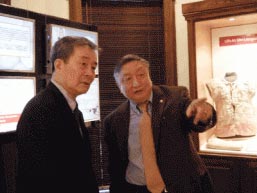
Harry Wu (L), Executive Director of the Laogai Research Foundation, with Lodi Gyari, Special Envoy for His Holiness the Dalai Lama (R) on March 31.
Speaking at the March 31 opening of an exhibit on prison labor camps in Tibet, Lodi Gyari praised the work of Harry Wu, the founder and Executive Director of the Laogai Research Foundation, in documenting the vast network of labor camps in China and Tibet. “Harry Wu’s work at the Laogai Museum is done for the same reasons that the Holocaust Museum was founded: to remember and to expose these ugly truths so that such things will never happen again,” Gyari said. “The Tibetan people can learn to forgive, but we must not forget.”
Lodi Gyari urged Tibetan youth in particular to learn about their family experiences from their parents and relatives. “This is a part of the legacy our Tibetan children have inherited, and it is the moral responsibility of every Tibetan family to know their history and to collect evidence of the events that have shaped their lives.”
The exhibit at the Laogai Museum opened exactly 50 years to the day that His Holiness the Dalai Lama crossed the Tibetan border into India, having departed Lhasa in the dark of night on March 17, to seek asylum from the Indian government and, as he has written, “to devote myself to keeping hope alive for my people everywhere.”
Harry Wu recalled in his remarks at the opening of the exhibit that, as a young man in Beijing in 1959, he went to an exhibition which purported to show atrocities in Tibet prior to its so called “peaceful liberation.”
In reality, as soon as the People’s Liberation Army had assumed full control of Tibet, an enormous program of labor camp construction got underway for the incarceration of the thousands of Tibetans who actively opposed or who were suspected of opposing China’s invasion of Tibet.
“What has happened over 50 years in Tibet?” Wu asked. “One, temples and monasteries were destroyed. Two, labor camps were built. This exhibit is here to portray that suffering,” Wu concluded.
The exhibit, “Laogai in Tibet” has been produced in collaboration with the International Campaign for Tibet and will run until May 30 at the Laogai Museum located at 1109 M Street NW, Washington, D.C. 20005.

